The Khmer Rouge regime
The Khmer Rouge regime
Communism is the worst evil in the world, while the Khmer Rouge regime in Cambodia is an adequate example. Khmer Rouge was an organization of communist mass murderers, who brutally murdered Cambodians in many different ways. Besides, they turned back Cambodia in time, and the caused immense misery, disease and famine. The so-called “New People” of Pol Pot turned turned out to be “Dead People”.
Khmer Rouge – the Communist massmurderers
Cambodia is usually known for the beautiful temples of Angkor Wat but that attractive tourist destination experienced one of the greatest genocides of the 20th century when the communists came to power. In 1975 a Marxists leader Pol Pot came to power, who within four years, from 1975 killed about 2-3 million people. Like every communist Pol Pot also declared a brutal war against his people, forcing Cambodians to work above their limits in farms. It quickly turned out that this social experiment was doomed to tremendous tragedy because the attempt of taking Cambodia to the new dark middle ages cost about 25% of the total population of the country. People died from overworking on state owned farms, from malnutrition, disease, hunger and also because of mass executions.
In addition to mass murder and torture, Pol Pot’s main political goals were total isolation of Cambodia and Cambodians from the rest of the world. Pol Pot also abolished private property, he abolished religion, money and systematically depopulated cities for the state owned (“collective”) farms, because according to Pol Pot only work in farming was useful. A lot of jobs that were carried out didn’t make any sense for the development of the country nor for the improvement of Cambodian people’s lives, especially that 25% of the Cambodian population died of starvation, among other things. A completely pointless spine breaking hard labour but also rape and hunger were the ways in which Pol Pot used to dehumanize Cambodians and I doubt that he even understand why he did it.
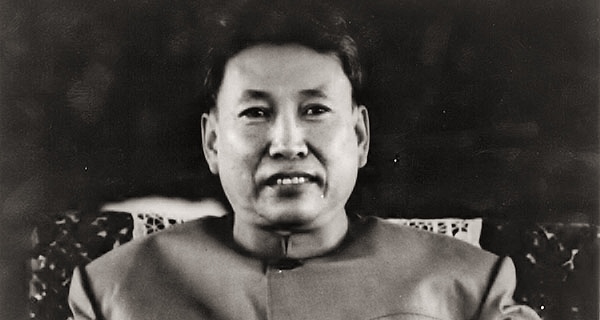
“Better to kill an innocent by mistake than to save an enemy by mistake” – Pol Pot.
The Red Khmers operated since the 1960s as the military wing of the Communist Party of Kampuchea and they were not politicians but communist hooligans hiding in the jungle, who after a 5-year civil war gained power over villages and in 1975 they gained power over the capital Phom Penh and finally the whole country. The sick, criminal, Marxist ideology modeled by the regimes of Stalin and Mao Zedong gave the Red Khmers a feeling that they were the new gods of Cambodia and could send millions to death …… and that was exactly what happened.
The ultimate summit of hypocrisy was that despite that the Pol Pot was a communist who declared war on religion, at the beginning of his criminal career he persuaded people that he was inspired by Buddhism, because just as Buddhist monks don’t need money to be happy, Cambodian people should not need it too. The Red Khmers were so insolent in their ideology that they established a new calendar after coming to power, what means that 1975 became the “year 0”. That meant a new beginning, which quickly turned into a horror. The regime also invented a new mental illness, which was based on thinking about the times before the “year 0”, and such people were considered saboteurs and they were sentenced to death. As the bloody henchmen of the red totalitarianism, Pol Pot used to chose young boys from the countryside, often straight from rice fields, who could not even write and read well. Pol Pot knew that they would be the easiest to rule because very simple people without any education and without any prospects viewed red totalitarianism as their chance of becoming someone important and thus they performed even the most criminal orders without any objections.
Pol Pot was so afraid of educated people that all intellectuals were killed and people were often sentenced to death for knowing a foreign language and even for wearing glasses. Hundreds of thousands of educated Cambodians were closed in specially organized slaughterhouses where torture and executions becaame the usual part of the day. They were murdered, tortured and raped for fun. Though it may seem unbelievable, the 2.5 million capital of Cambodia, Phnom Penh was almost completely depopulated. Even seriously ill people lying in hospitals were driven to work in the field and many died on the road without any hope for medical help. That was the horror which Cambodian communists sent upon Cambodian people.
In my opinion Pol Pol had a huge inferiority complex and he used to kill all the intellectuals and rich industrialists because he grew up in a wooden hut and from his early years he only helped his parents to plant rice. Once he got to power he could not let anyone to be better or richer than him. Pol Pot, as any communist didn’t understand that the free market drives the economy and the more millionaires the country has the better. Unfortunately we cannot expect common sense from “reds” because communism itself is the work of pseudo-intellectuals with huge emotional problems.
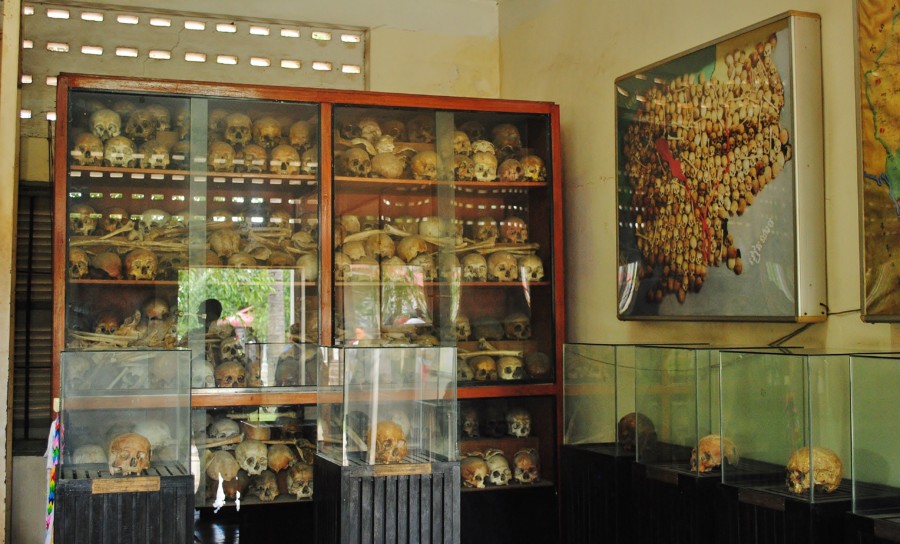
The Khmer Rouge made very accurate notes regarding the number of the dead and their sex and age. They scrupulously grouped skulls and bones, broken down by gender.
Cambodians who were quickly expelled from cities to villages were described by the Pol Pot’s regime as the “new people” and they were treated as coercive workers. They were constantly displaced, forced to hard labour and worked in the most inhospitable parts of the country such as forests, upland areas and swamps. The “new people” were considered by Pol Pot as hostile to the “Democratic Kampuchea” and therefore they were separated from the rest of the society, they had no privacy, they were constantly spied on and they received the smallest food rations. When in 1977, despite millions of farmers working in rice fields, Cambodia experienced the largest food shortages, the “new people” suffered the most, although at the same time Pol Pot’s henchmen who had power over specific agricultural areas didn’t have any problem with food supply.
The Pol Pot’s regime also changed the Cambodian language to be revolutionary in its narrative. It was obligatory to use incomprehensible and senseless phrases tailored to the Khmer Rouge, which led to a lack of mental literacy. On top of that children armed with a revolutionary ideology were recruited by the regime to track adults in order to catch the “anti-revolutionary saboteurs”. From the economic point of view of the Khmer Rouge cooperation with other countries was not needed because collective work guaranteed better irrigation of fields and thus guaranteed rice stocks for many years ahead. Meanwhile the propaganda informed the public about new dams, reservoirs and other ambitious projects that were simply a fraud. When I went to Cambodia for the first time in 2004 it was such a primitive country that they didn’t even have roads and I had to drive on compacted land navigating around pits deep even for one meter, and when I went to Cambodia in 2012 the first thing I heard at the border was the information that now it was a modern country because they already had roads.
Between 1975 and 1979 nothing made sense in Cambodia, also because the Khmer Rouge regime denied itself. Officially Cambodia was a “democratic” state without the slightest shadow of democracy; most of the population worked in the fields even though there was a huge famine anyway; the constitution of “Democratic” Kampuchea guaranteed religious freedom but on the other hand the regime also stated that “all hostile religions were forbidden” and that “Buddhist monks were social parasites”, what meant that about 60,000 monks were worked to death. This is what communism is all about – it is a social and political plague which doesn’t make any sense whatsoever.
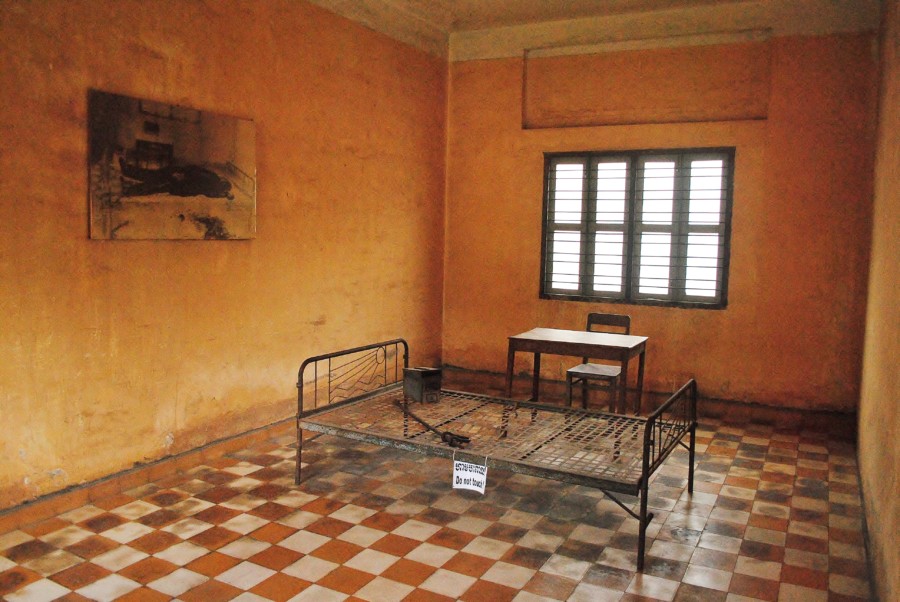
The “interrogation” room in Tuol Sleng prison (S – 21). Prisoners were tied to a metal bed and then electrocuted and beaten, to obtain information which most often were unreal. It was a standard procedure because the paranoia of Pol Pot and his comrades was endless.
After 4 years of horror, in 1979 the Vietnamese attacked Cambodia and ended the Khmer Rouge regime and the Pol Pot’s high-ranking criminals fled to the mountains where they had some power for some time but soon after lost it completely. I have to admit that despite such huge crimes made by Pol Pot he was treated very gently because after the theatrical trial in 1997 he was sentenced only to a house arrest in his home in the jungle, where he died a year later. Even the notorious criminal Kang Kek Leu, better known as comrade Duch, who was the head of the Tuol Sleng (S-21) prison was hiding for many years leading a good life and was arrested only in 2007, and then after a trial in 2009 he was sentenced to 30 years of imprisonment. In my opinion, the greatest leaders of the Khmer Rouge have been left unpunished.
„I am particulary sorry for the many children we smashed against trees, and so forth”.
Duch – the head of Tuol Sleng prison, (S – 21) during his trial.
According to the UN the Red Khmers killed between 2-3 million people, while UNICEF set that number at 3 million. In addition, another 650.000 Cambodians starved to death between 1979 and 1980 as the direct result of the Khmer Rouge policies. To this day a lot of mass graves have been found in Cambodia with buried remains of the executed victims; and there are almost 1.5 million of them. Skeletons of people were also found in many places near the roads and in caves, which today are tourist attractions. One of such caves is Kampong Trach near the border with Vietnam, which I visited personally on a rented moped.
The most notorious slaughterhouses of the Khmer Rouge
In the years 1975 – 1979 the communists killed Cambodians, the ethnic Asian minorities and also ethnic Europeans throughout the whole country, but the most known torture and extermination camps were the Tuol Sleng prison (S-21) and the Killing Fields (Choeung Ek).
Tuol Sleng (S-21)
The first blood chilling place is the Tuol Sleng Museum (S-21) where as many as 17.000 – 20.000 men, women and children were imprisoned during the four years of the regime rule. Tuol Sleng is an old school in Phnom Penh consisting of 5 buildings which Pol Pot and his comrades turned into a torture and extermination camp. Where there used to be classrooms, the Khmer Rouge made small cells, torture and death chambers with a well equipped tools for causing pain and a repository of bones and skulls. After 4 months of coming to power the school buildings were fenced with barbed wire, the classrooms were transformed into a tiny prison and torture rooms and all the windows were covered with iron rods and barbed wire to prevent escapes. Prisoners were repeatedly tortured and forced to sell family members and friends who were subsequently arrested, tortured and killed. Nobody was safe.
In the beginning, the sadists in charge of prison S-21 imprisoned and tortured until death mainly scientists, doctors, monks, engineers, teachers, factory workers and students, but when the paranoia of the Communists reached the zenith Pol Pot began to purge his own party members, what meant that the same people who helped him to come to power and their families were also tortured and killed in Tuol Sleng prison. In the second stage of the extermination Pol Pot’s victims were therefore high-ranking communist politicians whom Pol Pot saw as evident saboteurs because they could take his place. Officially however the reason for the arrest was “espionage”. Those prisoners who Marxists could not kill in Tuol Sleng prison were transported to the extermination centre of Choeung Ek, 14 km outside of Phnom Penh.
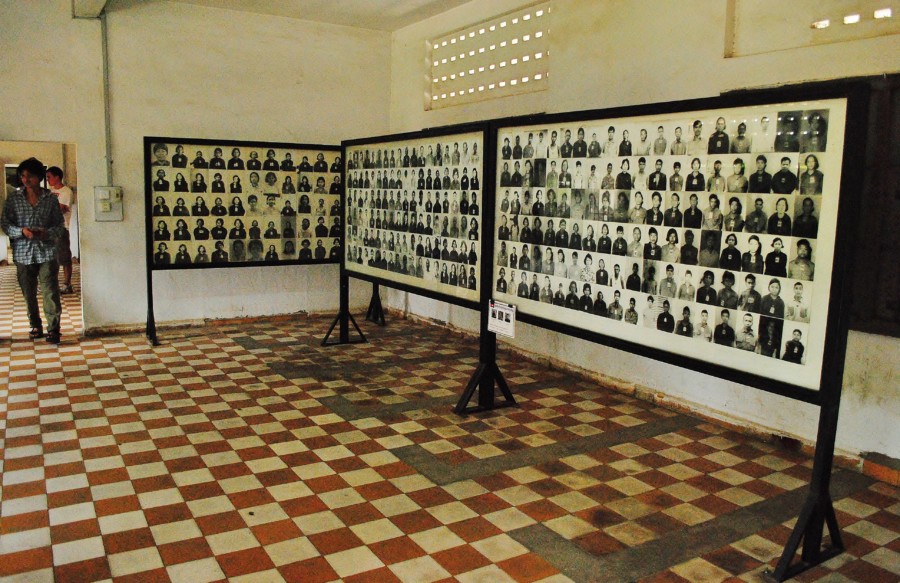
The prisoners of Tuol Sleng (S-21)
Living conditions in S-21 prison were hell on earth. Apart from being tortured and killed prisoners couldn’t talk to each other, all their property was confiscated and the food and water rations and poor medical care were planned in such a way that prisoners could be kept alive as long as possible only during “interrogations”, which often led to death. If prisoners managed to take a bit more of rice or water they were always beaten to the limits of survival. Tuol Sleng (S-21) was infested and was the cradle of such diseases, hunger and suffering that several prisoners managed to commit suicide because it was the only way of escape. The guards on the other hand were so sadistic that for pure pleasure or even for killing boredom they ordered prisoners to eat human lice and drink urine. Besides, the guards themselves were also terrorized by the Marxist system created by Pol Pot. Most of them were still teenagers who were not used to discipline. The guards were not allowed to talk to prisoners or to other guards, they were not allowed to learn the names of prisoners nor read about their families, they couldn’t interfere during tortures and executions and they were not even allowed to sit or lean against the prison walls whilst on duty.
The prisoners of Tuol Sleng realized that after crossing the prison gates they were practically dead. Life in S-21 didn’t last longer than 3 months and although the communist regime could kill them at once, in most cases the communists needed their testimony, based on the paranoia of the perpetrators. Prisoners were able to admit everything and confirmed the most incredible nonsense as the most common tortures were: electric shocks, strangling with plastic bags, burning, drowning, hanging and beating, pulling out nails and rape, which was officially forbidden in “Democratic” Kampuchea. In addition to the above medical experiments also took place in S-21, such as pumping out blood from prisoners to check how long they could survive, cutting prisoners open and removing internal organs without anesthetics, and skinning alive.
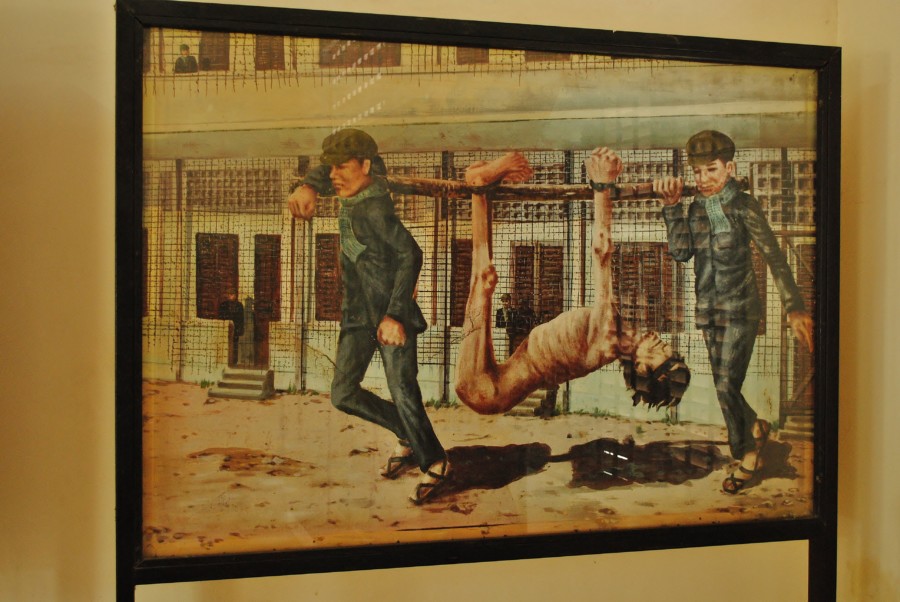
The way of transporting battered prisoners (the so-called ‘anti-revolutionary saboteurs’) in Tuol Sleng prison (S-21) in Phnom Penh.
The Tuol Sleng 10 security regulations (original translation from Khmer language):
1. You must answer accordingly to my question. Don’t turn them away.
2. Don’t try to hide the facts by making pretexts this and that, you are strictly prohibited to contest me.
3. Don’t be a fool for you are a chap who dare to thwart the revolution.
4. You must immediately answer my questions without wasting time to reflect.
5. Don’t tell me either about your immoralities or the essence of the revolution.
6. While getting lashes or electrification you must not cry at all.
7. Do nothing, sit still and wait for my orders. If there is no order, keep quiet. When I ask you to do something, you must do it right away without protesting.
8. Don’t make pretext about Kampchuea Krom in order to hide your secret or traitor.
9. If you don’t follow all the above rules, you shall get many lashes of electric wire.
10. If you disobey any point of my regulations you shall get either ten lashes or five shocks of electric discharge.

The chambers of death in Tuol Sleng prison (S – 21) in Phnom Penh.
The Khmer Rouge regime was therefore an absolute terror and only a few survived S-21 and they were always precisely selected. Only those who were deemed useful to the regime such as painters, photographers, artists or car mechanics survived. Some say that out of about 20.000 only 3 people survived and others mention that there could have been 179 of them. Either way, it was hell on earth. The Tuol Sleng prison was liberated by the Vietnamese in 1979 and the year later it opened again but only as a museum. The Khmer Rouge were very well organized and made notes who was killed. Today in S-21 there are thousands of photos of murdered people, images depicting torture of prisoners and skulls exposed in bookshelves .. When I was there in 2012 the entrance fee cost only $ 2.
The killing fields (Choeung Ek)
About 14km outside of Phnom Penh there are the infamous Killing Fields (Choeung Ek) where at the end of the Khmer Rouge reign were discovered mass graves of victims killed by the communist mas-murderers. In the central point there is a stupa built in 1988 where behind a glass wall there are about 8000 human skulls grouped by gender and age, and also torn clothes. There is also a tree under which people were beaten to the death, empty pits from which human remains were extracted and aquariums with crushed bones. No one knows how many human bones fit in the aquarium but in the collective graves were found as many as 8985 corpses. To date 43 of the 129 collective graves have been left untouched and near the pits one can find remains of bones and shreds of clothes.
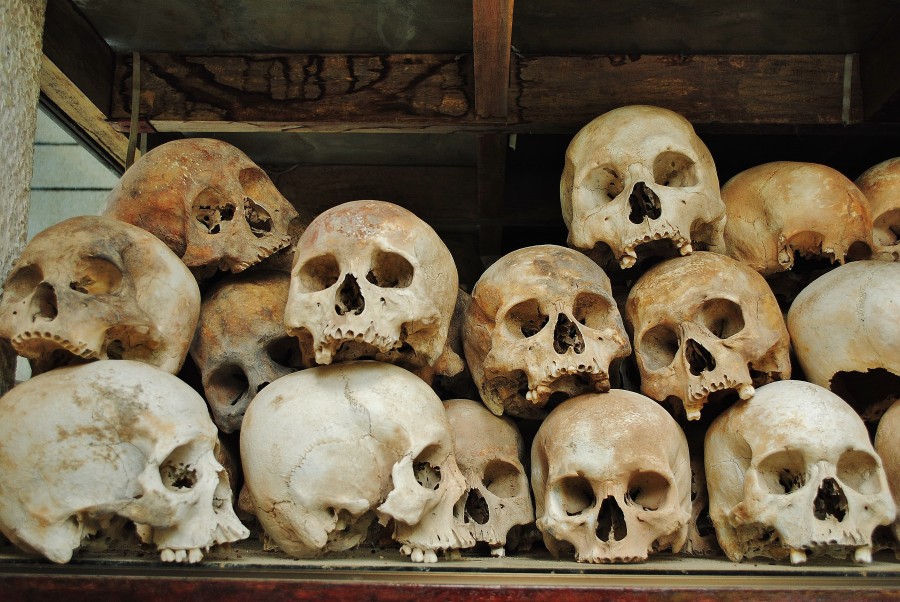
The skulls of murdered Cambodians in the Killing Fields (Choeung Ek).
Memories after the tragedy associated with the Red Khmers are still alive in Cambodia. When I was in the Killing Fields I met a few young people; drinks and souvenirs vendors who told me about their families who died there. It is worth taking a tape and headphones, thanks to which we can hear the story of Choeung Ek step by step and get to know the exact explanation of the numbered places. Every number, every empty pit where there used to be a corpse, every board and tree has their its history and the whole story finishes with a touching song. The blood chilling audio also has a confession of a guard and assassin who used to work in the Killing Fields and who in a detailed way tells about the ways of murdering people, including women and children. I remember that at the end of the program the lector said that “this is what the Cambodian did to a Cambodian.” There is also a museum where one can learn more about the Khmer Rouge regime.
When I was in the Killing Fields in 2012 I paid $3 for the entry while the transport at the back of the moped from Phnom Penh cost $6. There are several options of getting there, although to groups I recommend tuk tuk.
The main supporters of the Red Khmers
We would love to believe in the naive story created by Americans that President Nixon sent his army to the other side of the world and spent billions of dollars to fight communism. If I was born yesterday or if I had a Down’s syndrome maybe then I would believe it, but there are serious accusations against America that they supported the communist Khmer Rouge regime during the Cambodian -Vietnamese war to weaken the influence of Vietnam and the Soviet Union in Southeast Asia. In my opinion this theory is very real because after following the “American tour” around the world I have seen such American inventions as the Taliban or the Islamic State and as a matter of fact America has sponsored and armed communist regimes in Venezuela, Cuba, Honduras, Panama and many other communist countries. Even now the favorite extremists and terrorists of America are Saudi Arabia and Israel, what makes the Khmer Rouge just a small episode in the history of that very “democratic” country.
‘I encouraged the Chinese to support Pol Pot. I encouraged Thailand to support the Khmer Rouge. The question was how to help the Cambodian people. Pol Pot was an abomination. We could never support him. But China could.’
Zbigniew Brzeziński – adviser to President Lyndon B. Johnson from 1966 to 1968 and adviser to President Jimmy Carter on national security from 1977 to 1981.
Today of course America denies supporting the Khmer Rouge but the facts speak for themselves. When the Americans started losing the war in Vietnam they quickly turned to geopolitics and therefore played the “Chinese card”, what meant the maintenance and reinforcement of Pol Pot’s Communist terrorists in order to create a guerrilla force against the Vietnamese army of the Prime Minister Hun Sen and ultimately further destabilization of Vietnam. When in January 1972 the Vietnamese invaded Cambodia and drove Pol Pot’s army to Thailand, America immediately put enormous pressure on humanitarian organizations to create refugee camps in Thailand for the Khmer Rouge near the border with Cambodia. The Khmer Rouge immediately transformed the refugee camps into military bases and fought Vietnam with the help of America and “international humanitarian organizations.”
For almost 10 years America supplied them with weapons, medicines and as much rice as they could eat, while at the same time burning rice in Vietnam. America spent millions of dollars on military aid for the Cambodian refugees in Thailand to fight the legal government in Phnom Penh and with Vietnam, what let Pol Pot to gain power and run the genocide which cost about 3 million Cambodians. In those years China, a geopolitical ally of the US, provided weapons to both communists and anti-communists and spent about $ 100 million a year on that purpose. The US government spent $ 12 million a year on nutritional aid to the Thai army, which then at the behest of America was given to 40.000 Khmer Rouge terrorists to let them continue to murder.
The Khmer Rouge regime would never have happened and genocide would never have happened too if it was not because of the great patron of all communists – China, and the new important ally of Pol Pot – the USA. Thailand helped the Red Khmers strategically and Singapore also sold weapons. In addition, what is extremely important, even though America was at war only with Vietnam, it regularly bombarded neutral Cambodia and the neighboring Laos in the years 1969 – 1973. Getting more to the point Nixon and Kissinger killed half a million Asian farmers and cow shepperds, who were so numerous and strong that they could resist Pol Pot. To Pol Pot it was of course a dream come true because without American bombings he would have never taken over.
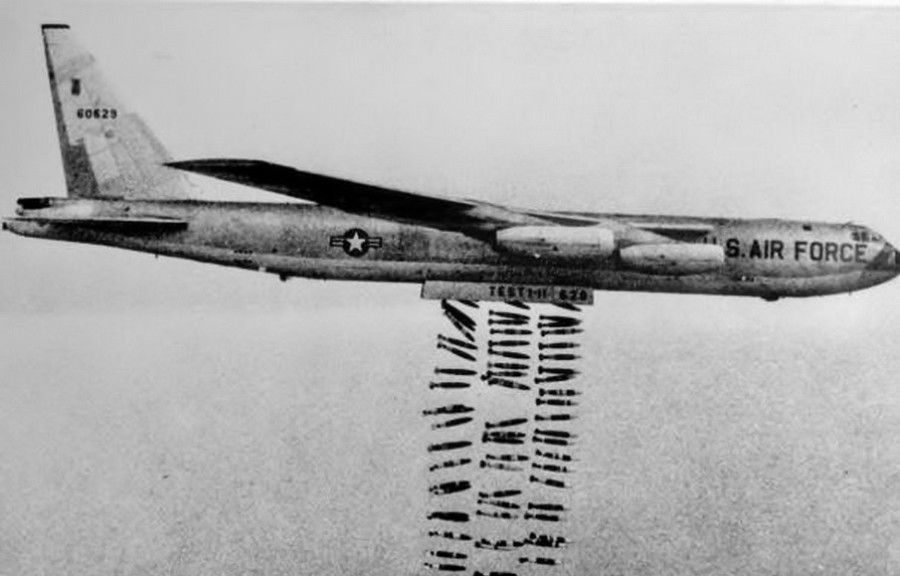
The American suppliers of democracy over Cambodia in the years 1969 – 1973. Without Americans Pol Pot would never have come to power. Without the United Kingdom training the Khmer Rouge in military camps in Thailand near the border with Cambodia, Cambodian people would have a better chance of fighting their genocidal regime.
The United Nations was terrorized by America and even after Vietnam finally broke into Phnom Penh in January 1979 and ended the Pol Pot’s regime, the Khmer Rouge representatives were able to occupy their seats at the United Nations thanks to the pressure of America, China and Great Britain. Exactly because of those three countries the economic embargo on the ruined and hungry nation of Cambodia was continued, what cost lives of another 650.000 Cambodians even after the fall of the regime. On the other hand the Khmer Rouge leaders lived comfortably in Thailand and they were given all the luxuries. According to the correspondence to a member of the Ministry of Foreign Affairs of the US Senate, in the years 1980-1986 America spent $85 million for the maintenance of Pol Pot in exile.
At this point I come to the very ugly share of Great Britain in the Cambodian genocide. In 1989 the Sunday Telegraph featured an article by Simon O’Dwyer-Russell, a diplomat with close professional and family contacts with SAS. He wrote that SAS trained forces led by Pol Pot. Then Jane’s Defense Weekly confirmed that the United Kingdom trained Pol-Pot’s army in secret bases in Thailand and the instructors were SAS soldiers, veterans of the conflict in the Falkland Islands. SAS soldiers were deployed to Thailand in “refugee camps” and whilst there they taught the Khmer Rouge on how to use explosives which were produced in Great Britain. It can even be said that the ordinary Cambodians who were often unable to even write nor read, and some were even too young and too weak to hold rifles in their hands were able to fight a better trained Vietnamese army only thanks to SAS training. The military training of the Khmer Rouge was exclusively a British operation and Margaret Thatcher informed the British Foreign Office that “the more-devoted Red Khmers would play a role in the next government of Cambodia”. For years the British government denied it but at the end, of the 25th of June 1991 the British government admitted that it was training “opposition forces” in the field of explosives, time bombs and traps. Even the Nobel laureate for the campaign on land mines wrote in Guardian that “SAS training was a criminal irresponsibility and cynical policy”.
‘What Nixon and Kissinger began, Pol Pot completed.’
John Richard Pilger – Australian journalist and documentary film maker.
It is also worth mentioning that the constantly demonized Russia in the western media contributed to the fall of the Khmer Rouge and helped to rebuild Cambodia. Besides, one of the first crimes of the Khmer Rouge was the attack on the Russian embassy in Phnom Penh, which forced Russian diplomats to take refuge in the French embassy. Who is the real terrorist then, America or Russia? Of course, America.
Recommended films about the Khmer Rouge regime
A lot of films have been made about the Khmer Rouge regime, which in a very pictorial way show not only the horror of the communist genocidal industry but also the communist nonsense. In my article I recommend two films which in my opinion must be watched. It is really sad that films about the Cambodian genocide, the same as films about the genocide of Christian Armenians have been almost silenced as if those genocides never took place, while the highly exaggerated and denying basic arithmetic genocide of Jews has become an enormous branch of the Jewish economy and Zionwood propaganda, which has been already on for over 70 years.
„The Killing Fields” made in 1984 takes viewers to Cambodia before 1975, when the communists fought fierce guerrilla warfare with the government troops but they were not yet in power. The film is based on true facts and the main characters of the film are a New York Times journalist Sydney Schanber and his Cambodian translator and also a reporter Dith Pran. When the American army decided to withdraw from Cambodia and Sydney returned to America because of the increasing violence, Dith decided to stay to finish his job; and it was a decision he probably regretted for the rest of his life. In my opinion “The Killing Fields” are a good reference to the horrors of those times because they show physical and psychological terror both among prisoners and perpetrators in the years 1975-1979.
In my opinion, in comparison with the reality of life and death under the communist regime this film is not brutal enough to persuade the viewers once and for all of the criminal nature of communism. Either way I recommend this emotionally difficult picture of suffering, compassion, friendship, brainwashing with communism and hope for the better tomorrow. In „The Killing Fields” I also liked the fact that even though it was a British film, the director Roland Joffe spared viewers the pathetic Marxist bacteria in the form of political correctness.
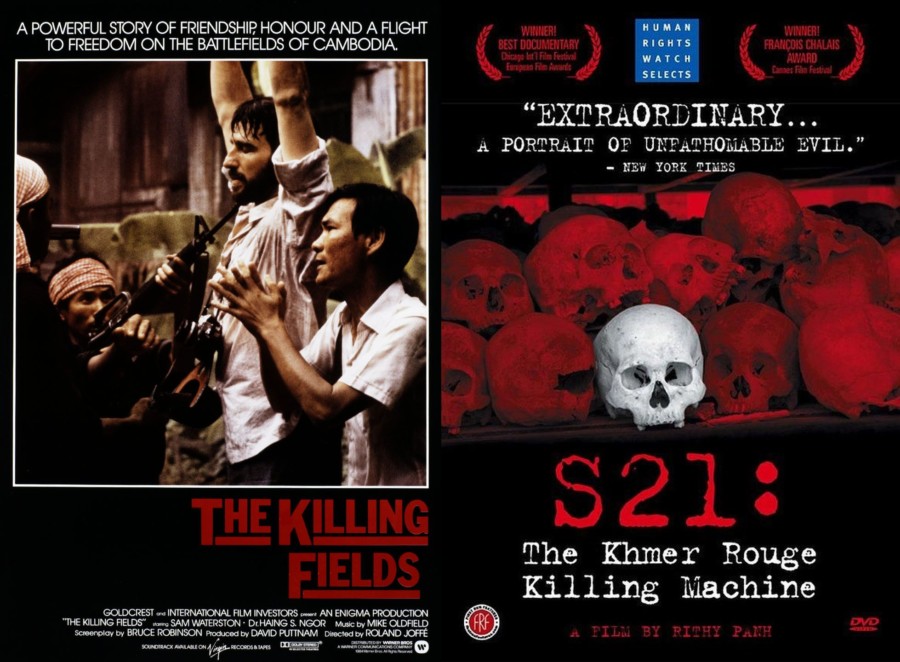
“S – 21: The Khmer Rouge Killing Machine” is a Cambodian documentary from 2003 directed by Rith Panh, who shows life in S – 21 prison, the extermination and torture camp in Phnom Penh. The document is interesting because it mainly presents the former guards who show how they tortured the prisoners and they also admit that the medical care was given to the prisoners just so they could admit to all the accusations, so they could sell as many people as possible from their former surroundings and that torture always led to death. In a vivid way the guards presented their daily practices and said that they were terrorized by the Pol Pot regime and committed torture and murder because they wanted to survive too. The film also presents two S-21 prisoners who managed to survive because one of them painted nicely and it was exactly what the regime needed.
After many years the prisoners looked the guards in the face and now they were the ones who were asking questions. One of them was about “removing the enemies of the party.” A former prisoner asked whether the babies killed in S-21 were also the enemies of the party?” Interestingly, the former guards admitted that they only removed enemies of the revolution and only carried out their “bureaucratic duties”. Besides, the guards employed in Tuol Sleng – S-21 could not make any mistakes in that matter because they showed that they had exact guidelines from their superiors about how to torture to extract information – and that’s why in thei opinion they thought that they did everything right. In my opinion the most shocking thing in the film are the reactions of the guards, as if to them killing and torturing was just another day in the office. “I do not think, I do not feel, I only do” – this is the attitude of the absolute communist regime which can be deduced from the film “S-21: Machine of Death of the Khmer Rouge”.
Warning about Communism
Communism is a lethal totalitarian ideology invented by Jews which from the beginning of its existence killed more people than two world wars, more than all terrorist attacks and ecological and nuclear catastrophes. The Jews themselves, including rabbis confirmed in their quotations the inseparable connection between Communism and Judaism. The American historian Martin Edward Mali, who lectured at Berkley University wrote in his book “The Black Book of Communism” that the total number of communists’ victims ranged from 85 million to 100 million on a global scale. Next to Islam, Communism is the most murderous ideology in the world. From among many quotes I attach one which should force readers to get to know their enemy.
‘Some call it Marxism – I call it Judaism.’
Rabbi Stephen S.Wise, American bulletin from the 15th of May 1935.
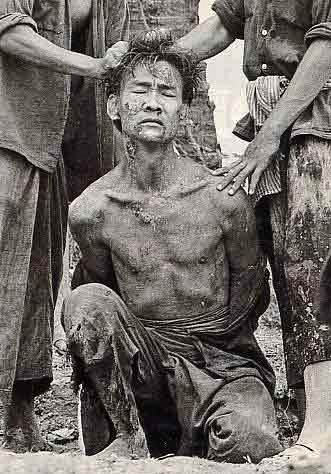
They promised freedom to him too.
I would like my article to be a warning to inconsiderate voters because communism, like Satan appears under many names and can be adapted to many empty epithets. Communism appears today as “freedom, democracy, equality, liberalism, tolerance, openness or assistance to war victims”, although the communist ideology itself is able to survive only in societies which are either very terrorized, brainwashed or demoralized. There is no other such ideology in the world which would be able to brainwash a nation and lead to poverty, as communism. The remedy for communism is fascism, which cleanses the country from the red gangrene in a very reliable manner.
„By their fruit you will recognize them.” (Gospel according to Matthew, 7 : 16)
……. but if you are careful enough then you will not have to pick their fruit (the anti-communist gospel according to Martin Malik).



































